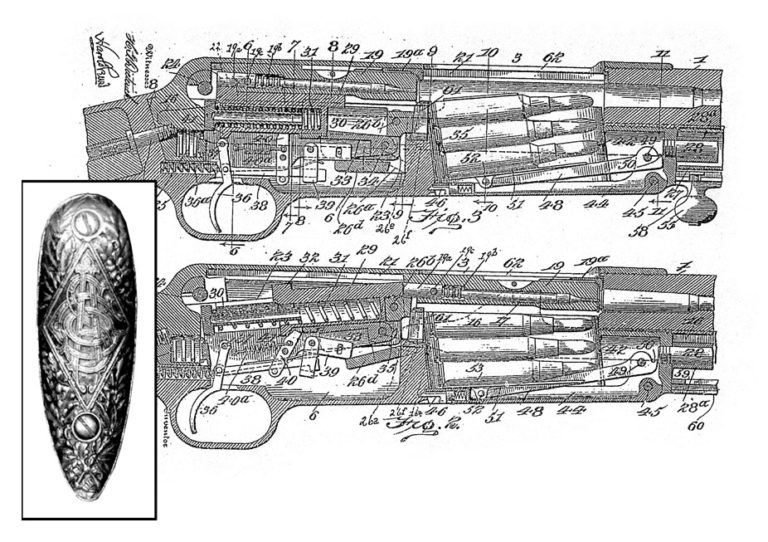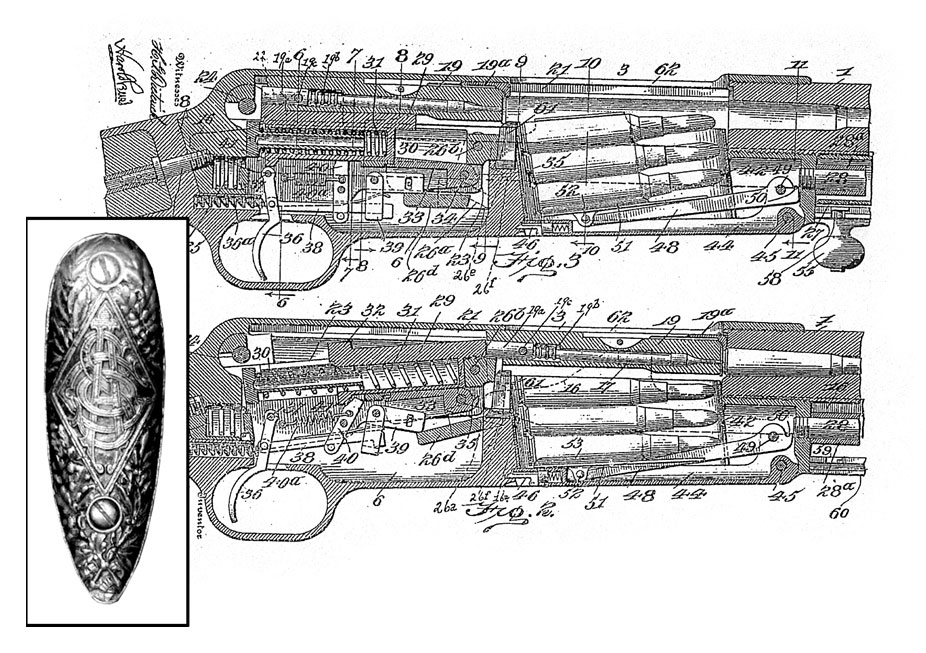

The road to progress is not without its occasional pothole. One notable example with firearms is the Cochran Turret Revolver, an early percussion handgun in which the rotating, slab-like cylinder was mounted flat on its side with its chambers pointing outward like the spokes of a wheel. Thus, at any given moment, at least one of the loaded chambers was always pointed backward — toward the shooter. (Oops!)
The Late, Great Model G
Another example is the Standard Model G, America’s first gas-operated semiautomatic sporting rifle. Arguably the most unique American rifle — a combination autoloader and pump repeater — the Model G was a lesson in how even the best concept can go astray. We must pity Morris F. Smith of Philadelphia, Pa., who thought the thing up.
Not much is known of Smith. We know, however, that on March 6, 1906, he was awarded Patent No. 314,242 for an “automatic gas-operated rifle,” illustrated nearby.
Gas-operated arms were nothing new; John Browning had designed a workable gas-operated machine gun, the Colt Potato Digger, nearly a decade earlier. But no one had yet adapted the force of expanding gas to a semiautomatic sporting rifle until Smith did so.
Other types of semiauto sporting rifles were available in 1906. Winchester’s Model 1903 (later the Model 63) .22 Self-Loading Rifle was already a smash hit. Also that year, Browning designed a high-powered semiauto that would still be offered a half-century later: the classic Remington Model 8 (later the M81). Winchester followed the 1903 with the models 1905 and 1907 centerfire semiautos, the latter of which only succumbed to the wheels of progress in 1957. But until the Model G, the only autoloaders that made it into production in America were the Remington and Winchester’s self-loaders.
All those rifles were based on long-recoil (Remington) or straight blowback (Winchester) actions. True, Winchester’s William Mason had begun work on an experimental gas-operated autoloader about 1900, but it never made it past the prototype stage. Nowadays, when almost every centerfire semiauto rifle and shotgun is gas-operated, we should remember that it started with the Standard Model G.
Smith’s patent specification pretty well summed up the idea behind the Model G: “My present invention relates to firearms or guns in which powder-gas pressure developed in firing is utilized for actuating the working parts in reloading after each shot is fired.”
So far, so good. In the next line, however, Mr. Smith entered the realm of fiction: “(The object) is to greatly simplify the mechanism of such a gun and to render it more reliable in action and more durable in use.”
“Reliable?” “Durable?” Does the Model G’s “mechanism” in the patent drawing above appear to be simplified to you?
Problems Abound
Nowadays, we can be sure that Smith was the only person who ever used those terms with the Standard Model G. Soon after its introduction in 1910 by the Standard Arms Co. of Wilmington, Del., the Model G acquired a toxic and enduring reputation as a jammer.
All guns jam, of course. It goes with the territory. But the Model G brought a new dimension to the word “jam.” When other guns jam, you spend a few minutes monkeying with a stovepiped shell casing or, at worst, a broken extractor. When a Model G jams, however, your shooting is finished for the day — if not the week.
I’m afraid I speak from experience. I have owned three Model Gs, one in each available chambering (.25, .30 and .35 Remington). Each was a heartbreaking, maddening jammer.
The problem with the Model G was that no steel then in general use could withstanding the ferocious energy of expanding powder gas.
In Smith’s design, the expanding gas bled from the barrel via an adjustable port and traveled backward toward the bolt through a gas tube below the barrel. The gas exited the tube to push against a cup-shaped piston, which was attached with a feeble crosspin to a scissors-like pair of bolt extensions. When all went well, which was too seldom, the piston thrust the bolt extensions backward, initiating the extraction-ejection-reloading cycle.
When all did not go well — usually on the third or fourth shot — the wimpy little crosspin sheared off and locked up the entire works. The shooter was done for the day (unless you count muttered profanity).
It wasn’t supposed to be that way, Standard Arms insisted. The Model G was supposed to be “the neatest looking, handiest to carry, easiest to operate, quickest to reload, best all-round automatic rifle in the world,” according to the Model G owner’s manual sent to me by friend Dan van Vorst of Palominas, Ariz.
True, the Model G had a lot going for it. It incorporated a flush-mounted, bottom-opening integral magazine that permitted the use of pointed bullets. Its gas action mitigated recoil, and its lines were surprisingly modern and businesslike.
But in the guts department, the Model G just wasn’t up to the job.
Perhaps Smith had an inkling of the weakness of his concept because he designed the Model G to function as a manually operated pump rifle, too. By closing the adjustable gas port and pressing in on a small button in the rifle’s forearm, you could rack the action much as you would that of a pump shotgun.
Let’s talk about that forearm. It might be the most beautiful or gaudiest piece of metalwork ever to grace a firearm. Cast of brass alloy, it features a bas-relief moose and assorted Germanic scrollwork. The matching buttplate, shown nearby, is probably the busiest, most intricate of all time.
Still, a pretty forearm and buttplate weren’t enough to save the Model G.
Within several years of the Model G’s introduction, as the skies over America’s hunting grounds turned blue with a chorus of curses directed at the doomed rifle, Standard Arms Co. threw in the towel. They discarded the Model G’s gas system and put their money on the pump-only Model M (as in “manual”), a dumbed-down version of the G. That was to no avail, however. By then, the Remington Model 8 had sold shooters on the virtues of the semiauto. Standard Arms Co. sank from sight without a ripple before 1920.

Next Step: Get your FREE Printable Target Pack
Enhance your shooting precision with our 62 MOA Targets, perfect for rifles and handguns. Crafted in collaboration with Storm Tactical for accuracy and versatility.
Subscribe to the Gun Digest email newsletter and get your downloadable target pack sent straight to your inbox. Stay updated with the latest firearms info in the industry.

![Best Concealed Carry Guns In 2025 [Field Tested] Wilson Combat EDC X9S 1](https://gundigest.com/wp-content/uploads/Wilson-Combat-EDC-X9S-1-324x160.jpg)


![Best 9mm Carbine: Affordable PCCs [Tested] Ruger Carbine Shooting](https://gundigest.com/wp-content/uploads/Ruger-Carbine-Shooting-100x70.jpg)
![Best AR-15: Top Options Available Today [Field Tested] Harrington and Richardson PSA XM177E2 feature](https://gundigest.com/wp-content/uploads/Harrington-and-Richardson-PSA-XM177E2-feature-100x70.jpg)

Sad to hear about such a small part causing such angst for both its designer and the defunct company. To be fair though, I’ve shot the Remington Model 8 and 81, and the latter kicks like a mule in .300 Savage caliber.
Lest my observation seem unfair with that rifle’s long-recoil design a la Auto 5, I am pretty much recoil proof due to my ownership of a .375H&H, .416 Rigby, and .458 Win Mag over the years.
Nice article though!
I have a .25 cal. model G. It is a fun gun but really hard to have a good day at the reange.